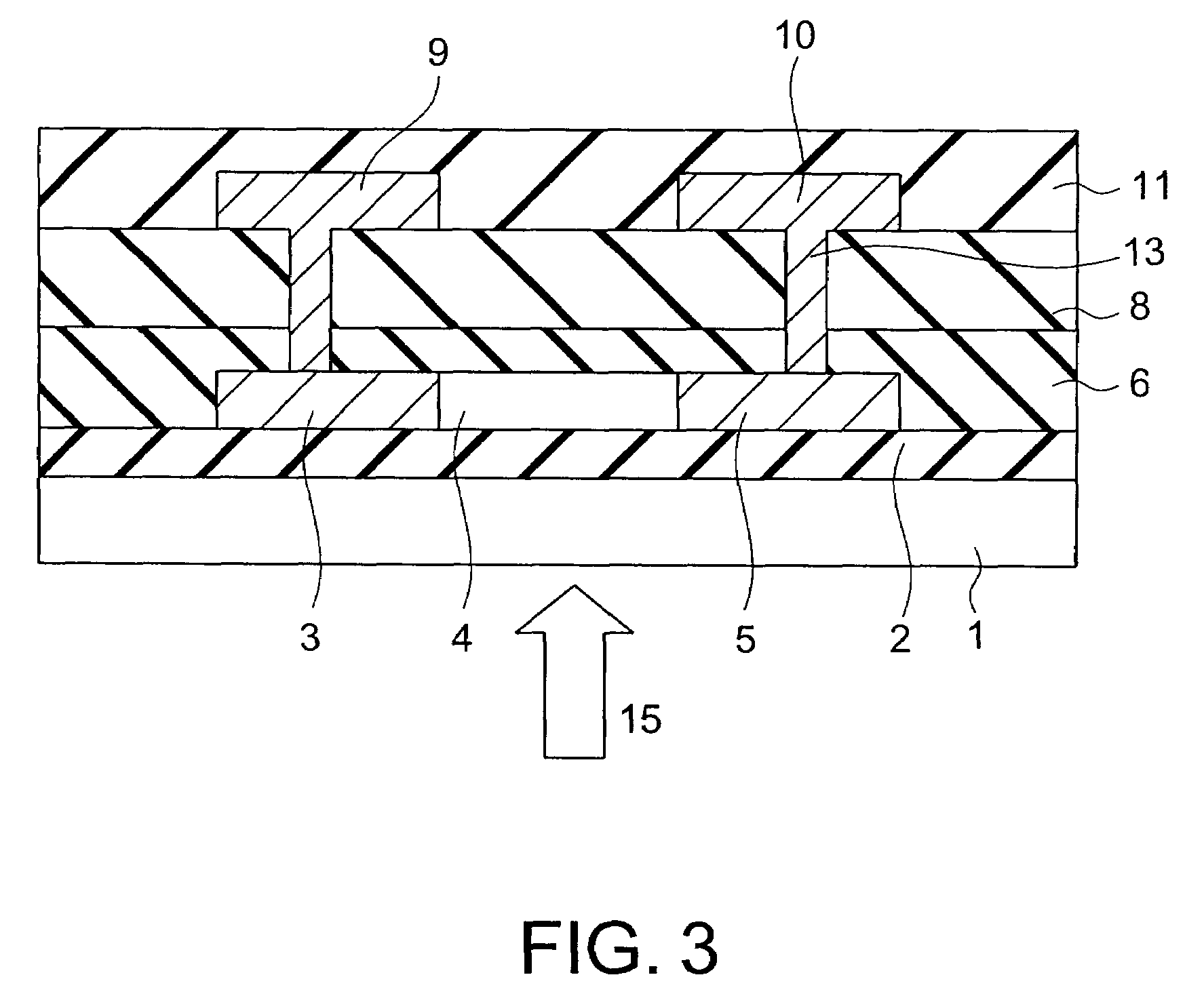Optical sensor element and method for driving the same
a technology of optical sensor element and optical sensor, which is applied in the direction of basic electric elements, electrical apparatus, semiconductor devices, etc., can solve the problems of small magnitude of photocurrent and increase in process number, and achieve the effect of small output variation and large photocurrent outpu
- Summary
- Abstract
- Description
- Claims
- Application Information
AI Technical Summary
Problems solved by technology
Method used
Image
Examples
first embodiment
[0056]An optical sensor element according to a first embodiment of the present invention will now be described. The optical sensor element according to the present embodiment is a lateral pin structure diode. Its plan view is shown in FIG. 1 and its sectional view is shown in FIG. 2.
[0057]An undercoat layer 2 formed of silicon nitride (SiNx) or silicon oxide (SiOx) is formed on a glass substrate 1 so as to have a thickness in the range of 50 to 200 nm by using the plasma CVD (Chemical Vapor Deposition) method or the like. A polycrystalline silicon film is formed on the undercoat layer 2 so as to have a thickness in the range of approximately 50 to 100 nm. This polycrystalline silicon film includes a p+-region 3 doped with boron having a high concentration of approximately 1×1019 cm−3, an n+-region 5 doped with phosphorus having a high concentration of approximately 1×1019 cm−3, and an i-region 4 which is provided between the p+-region 3 and the n+-region 5 and which is lower in conc...
second embodiment
[0065]A second embodiment of the present invention is a TFT array. A TFT array is formed by arranging the optical sensor elements of lateral pin structure diode type according to the first embodiment and thin film transistors on a substrate in a matrix form. A TFT-LCD with optical sensors integrally formed is thus implemented.
[0066]It becomes possible to conduct operation in the irradiation light intensity-determining region and reduce the variation ξ of the photocurrent as compared with that in operation in the lifetime-determining region, by making the reverse bias voltage Vb applied at the time of photocurrent detection higher than the saturation voltage Vsat so as to satisfy the following relation.
Vsat<VbVsat (20)
The saturation voltage Vsat varies by approximately 20% at maximum among elements. By selecting the length Li of the i-region 4 so as to satisfy the expression (20), therefore, the photodiode is made to operate in the irradiation light intensity-determining region w...
third embodiment
[0067]An optical sensor element of lateral pin structure diode type according to a third embodiment of the present invention will now be described. A plan view and a sectional view of the optical sensor element (photodiode) according to the present embodiment are shown in FIGS. 6 and 7, respectively.
[0068]The optical sensor element according to the present embodiment has a configuration obtained from the optical sensor element according to the first embodiment shown in FIGS. 1 and 2 by providing a gate electrode 7 on the silicon oxide film (gate insulation film) 6 so as to cover a partial region of the i-region 4. In the present embodiment, the partial region of the i-region 4 is provided on the anode electrode 9 side, and the partial region of the i-region 4 is shorter in length than the length Li of the i-region 4, but has the same width W as that of the i-region 4. By the way, the gate electrode 7 is covered by the silicon oxide film 8.
[0069]In the same way as the first embodimen...
PUM
 Login to View More
Login to View More Abstract
Description
Claims
Application Information
 Login to View More
Login to View More - R&D
- Intellectual Property
- Life Sciences
- Materials
- Tech Scout
- Unparalleled Data Quality
- Higher Quality Content
- 60% Fewer Hallucinations
Browse by: Latest US Patents, China's latest patents, Technical Efficacy Thesaurus, Application Domain, Technology Topic, Popular Technical Reports.
© 2025 PatSnap. All rights reserved.Legal|Privacy policy|Modern Slavery Act Transparency Statement|Sitemap|About US| Contact US: help@patsnap.com



